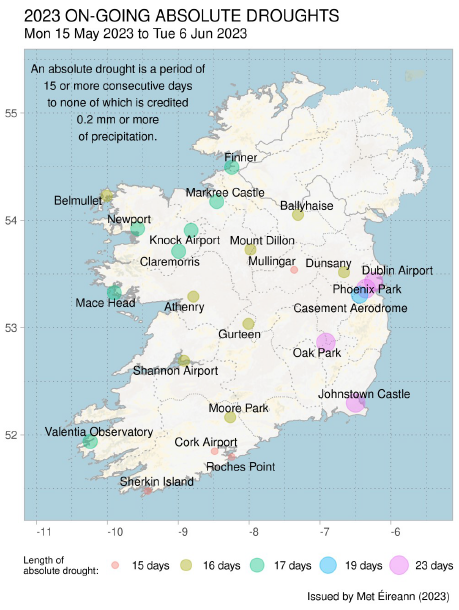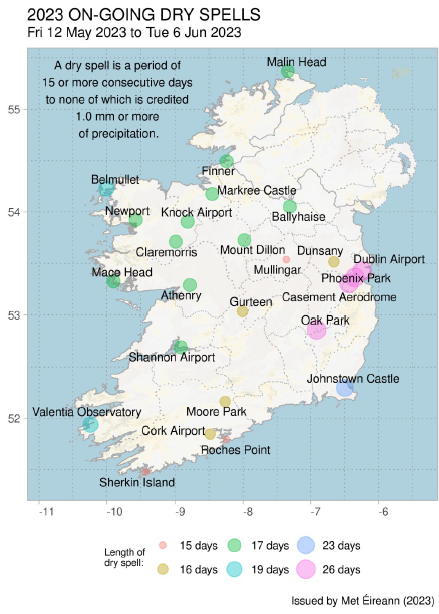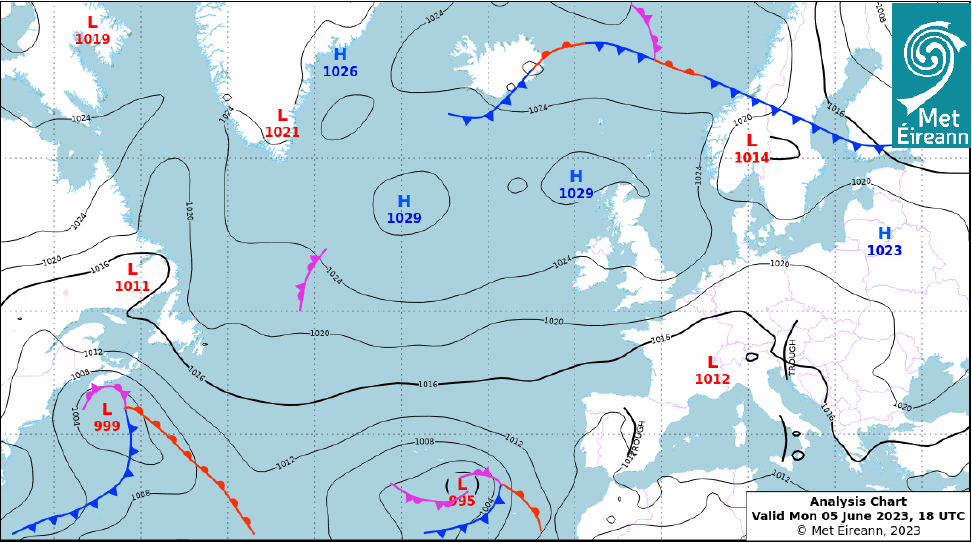A stable area of blocking high pressure situated over and to the north of Ireland since mid May has kept the North Atlantic jet stream and associated low pressure systems well away from our shores. This has resulted in mostly dry conditions across the country for an extended period, resulting in widespread climatological dry periods. These began in the East of Ireland towards the end of May and became widespread across the country over the last few days. 25 out of 25 synoptic stations (Met Éireann’s network of principle weather stations) are now experiencing dry periods lasting between 15 and 26 days. Such widespread dry periods have not occurred in Ireland since the summer of 2018. The forecast is for mostly dry conditions to continue over the next few days with some rain possible on Saturday 10 June as low pressure encroaches from the south.
Analysis of climatological dry periods in Ireland are determined using daily rainfall accumulations. Dry periods can occur at any time of the year in Ireland but usually have more impacts during the spring and summer months. The definitions of which depend on the spell duration and deficiencies in the total daily amounts of rainfall. Climatological dry periods are classified as dry spells, absolute droughts and partial droughts. An absolute drought is often part of a more extensive dry spell. In prolonged droughts, two or all three categories may overlap and in some cases coincide.
A dry spell is a period of 15 or more consecutive days with daily precipitation of less than 1.0mm (that is daily rainfall < 1.0mm).
A partial drought is a period of at least 29 consecutive days where the mean daily rainfall does not exceed 0.2mm (that is, a mean for period ≤ 0.2 mm per day).
An absolute drought is a period of 15 or more consecutive days with daily precipitation of less than 0.2mm (that is, a daily rainfall total < 0.2mm).
Climatological absolute droughts (< 0.2 mm daily rain)
24 out of 25 synoptic stations are currently observ-ing absolute droughts lasting between 15 and 23 days.
The longest absolute droughts of 2023 are on-going at four stations in Wexford, Dublin and Carlow with 23 consecutive days.
The only previous absolute drought during 2023 ended on Thursday 9 February at Johnstown Castle, Co Wexford lasting 16 consecutive days.
The last absolute drought prior to 2023 ended on Saturday 2 April 2022 at Athenry, Co Galway, Mace Head, Co Galway (16 days) and Shannon Airport, Co Clare (17 days).
Climatological dry spells (< 1.0 mm daily rain)
25 out of 25 synoptic stations currently observing dry spells lasting between 15 and 26 days.
The longest on-going dry spells are at three stations in Dublin and Carlow with 26 consecutive days.
The longest dry spell of 2023 so far ended on Mon-day 13 February at Dublin Airport, Co Dublin and Dunsany, Co Meath with 30 consecutive days.
Climatological partial droughts (29 or more days with mean daily rainfall of less than 0.2 mm)
There are currently no partial droughts being ob-served at synoptic stations.
The longest partial droughts of 2023 were at Dublin Airport, Co Dublin (31 days) and Phoenix Park, Co Dublin (30 days) between Saturday 14 of January and Tuesday 14 February
The last partial drought prior to 2023 was 30 days long at Johnstown Castle, Co Wexford from Sunday 28 March 2021 to Monday 26 April 2021.
SYNOPTIC stations are meteorological stations that send SYNOP (Surface Synoptic Station) messages used for reporting – almost all – weather elements, at fixed times, multiple times a day, worldwide to other Met Services. See https://www.met.ie/climate/weather-observing-stations for details of some of these stations.


